|
 
- UID
- 1023166
- 性别
- 男
- 来自
- 燕山大学
|

TI MSP-EXP430G2 LaunchPad开发解决方案
TI公司的MSP430F15x/16x/161x系列是超低功耗微控制器,集成了两个16位计时器,快速12位ADC,双路12位DAC,一个或两个USART,I2C,DMA和48个I/O引脚.工作电压1.8 V - 3.6 V, 1 MHz和2.2 V是的功耗仅330 μA,五种降功耗模式,典型应用包括传感器系统,工业控制和手持仪表等.本文介绍了MSP430F161x 主要特性,方框图以及MSP-EXP430G2 LaunchPad低成本实验板主要特性,电路图,材料清单和PCB元件布局图.
MSP430F15x, MSP430F16x, MSP430F161x MIXED SIGNAL MICROCONTROLLER
德州仪器的MSP430超低功耗微控制器系列,包括几个具有不同外设装置的器件,用于各种不同的应用。其架构结合了五种低功耗模式,并进行了优化,以延长便携式测量应用的电池寿命。该器件具有强大的16位RISC CPU,16位寄存器和常数发生器,有利于实现最大的代码效率。其数控振荡器(DCO)使得从低功耗模式,到主动模式的唤醒不到6µs。
MSP430F15x/16x/161x系列为微控制器的配置,内置两个16位定时器、一个快速12位A/D转换器、双12位D/ A转换器、一个或两个通用串行同步/异步通信接口(USART),I2C,DMA和48个I/O引脚。此外,MSP430F161x系列还提供了扩展的内存寻址,用于内存密集型应用程序和大型C堆栈。典型的应用包括传感器系统、工业控制应用、手持电表等。
MSP430F161x主要特性
•低电源电压范围:1.8V~3.6V
• 超低功耗
–主动模式:330µA,1MHz,2.2V
–待机模式:1.1µA
•关闭模式(RAM保持):0.2µA
•五个省电模式
•待机模式到唤醒不到6µs
• 16位RISC架构,125ns指令周期时间
•三通道内部DMA
• 12位模拟到数字(A/D转换)转换器,具有内部参考、采样和保持以及AutoScan功能
•双12位数字-模拟转换器(A/D)同步
•16位定时器A,三个捕获/比较寄存器
•16位定时器B,具有三个或七个捕捉/比较与阴影寄存器
•片上比较器
•串行通信接口(USART0),异步UART,或同步SPI,或I2CTM接口功能
•串行通信接口(USART1),异步UART,或同步SPI接口功能
•提供电压监控/监视器,及可编程电平检测
•掉电检测
•引导加载程序I2C是飞利浦股份有限公司的注册商标
•板载串行编程,无需外部编程电压,安全熔丝可编程代码保护
系列成员包括:
• MSP430F155
– 16kB+256B闪存
– 512B的RAM
• MSP430F156
–24kB+256B闪存
–1kB的RAM
• MSP430F157
–32kB+256B闪存
–1kB的RAM
• MSP430F167
–32kB+256B闪存
–1kB的RAM
• MSP430F168
– 48kB+256B闪存
–2kB的RAM
• MSP430F169
– 60kB+256B闪存
– 2kB的RAM
• MSP430F1610
– 32kB+256B闪存
– 5kB内存
• MSP430F1611
– 48kB+256B闪存
–10kB的RAM
• MSP430F1612
– 55kB+256B闪存
– 5kB RAM
64引脚QFP封装(PM)和64引脚QFN封装(RTD)。
MSP-EXP430G2实验板
MSP-EXP430G2低成本实验板(称为LaunchPad)是德州仪器MSP430G2xx系列的一个完整的开发解决方案。基于USB的集成仿真器提供了开发MSP430G2xx系列器件应用的,所有必要的硬件和软件。LaunchPad有一个集成的DIP,用于插槽,支持多达20个引脚,可以将MSP430器件装入LaunchPad板。它具有一个板上闪存仿真工具,可以直接连接PC,易于编程、调试和评估。LaunchPad实验板可以给eZ430-RF2500T目标板、eZ430-Chronos模块或eZ430-F2012T/F2013T目标板编程。USB接口具有一个9600Baud UART串行连接,以连接MSP430G2xx和PC主机或目标板。
MSP-EXP430G2可以与IAR Embedded Workbench集成开发环境(IDE)或Code Composer Studio(CCS)IDE一起使用,用于书写、下载和调试应用程序。
调试器并不是必须使用,用户可以全速运行应用程序,可较大化地使用现有硬件和单步执行,而不用其他硬件资源。
MSP-EXP430G2 LaunchPad主要特性
• USB调试和编程接口,为无驱动器安装和应用UART串行通信,最高为9600Baud
•支持所有PDIP14或PDIP20封装的MSP430G2xx和MSP430F20xx器件
•两个通用数字I/O引脚,以连接绿色和红色发光二极管,用于视觉反馈。
•两个用户反馈和设备复位按钮
•方便的引脚可以接入调试设备,或添加用户的扩展板
•高品质的20引脚DIP插座,插件灵活方便
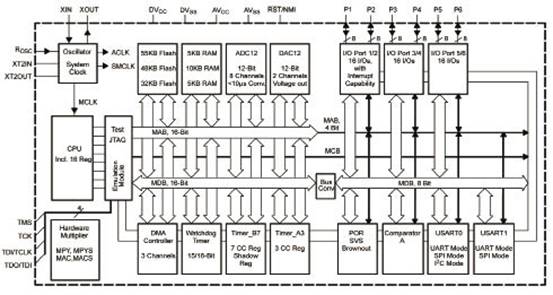
图1 MSP430F161x方框图
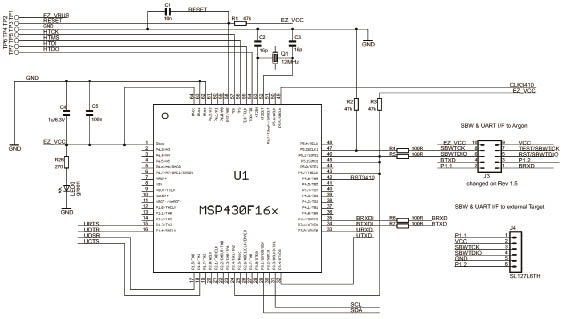
图2 MSP-EXP430G2 LaunchPad电路图(1)
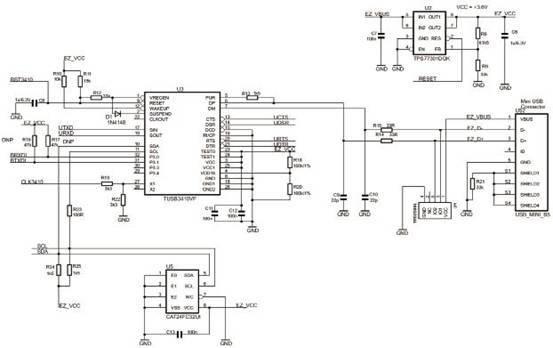
图3 MSP-EXP430G2 LaunchPad电路图(2)
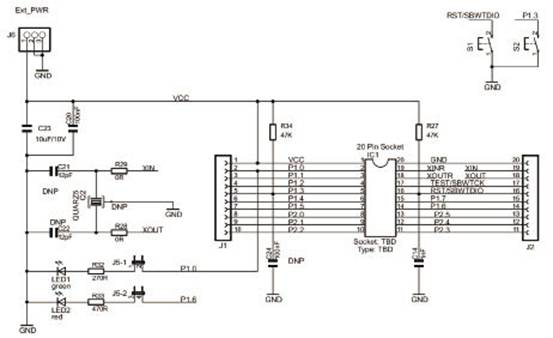
图4 MSP-EXP430G2 LaunchPad电路图(3)
The Texas Instruments MSP430 family of ultralow power microcontrollers consist of several devices featuring different sets of peripherals targeted for various applications. The architecture, combined with five low power modes is optimized to achieve extended battery life in portable measurement applications. The device features a powerful 16-bit RISC CPU, 16-bit registers, and constant generators that contribute to maximum code efficiency. The digitally controlled oscillator (DCO) allows wake-up from low-power modes to active mode in less than 6 μs.
The MSP430F15x/16x/161x series are microcontroller configurations with two built-in 16-bit timers,a fast 12-bit A/D converter, dual 12-bit D/A converter, one or two universal serial synchronous/asynchronous communication interfaces (USART), I2C, DMA, and 48 I/O pins. In addition, the MSP430F161x series offers extended RAM addressing for memory-intensive applications and large C-stack requirements.
Typical applications include sensor systems, industrial control applications, hand-held meters, etc.
MSP430F161x 主要特性:
Low Supply-Voltage Range: 1.8 V to 3.6 V
Ultralow Power Consumption
− Active Mode: 330 μA at 1 MHz, 2.2 V
− Standby Mode: 1.1 μA
Off Mode (RAM Retention): 0.2 μA
Five Power-Saving Modes
Wake-Up From Standby Mode in Less Than 6 μs
16-Bit RISC Architecture,125-ns Instruction Cycle Time
Three-Channel Internal DMA
12-Bit Analog-to-Digital (A/D) Converter With Internal Reference, Sample-and-Hold, and Autoscan Feature
Dual 12-Bit Digital-to-Analog (D/A) Converters With Synchronization
16-Bit Timer_A With Three Capture/Compare Registers
16-Bit Timer_B With Three or Seven Capture/Compare-With-Shadow Registers
On-Chip Comparator
Serial Communication Interface (USART0), Functions as Asynchronous UART or Synchronous SPI or I2CTM Interface
Serial Communication Interface (USART1), Functions as Asynchronous UART or Synchronous SPI Interface
Supply Voltage Supervisor/Monitor With Programmable Level Detection
Brownout Detector
Bootstrap Loader I2C is a registered trademark of Philips Incorporated.
Serial Onboard Programming, No External Programming Voltage Needed,Programmable Code Protection by Security Fuse
Family Members Include
− MSP430F155
16KB+256B Flash Memory
512B RAM
− MSP430F156
24KB+256B Flash Memory
1KB RAM
− MSP430F157
32KB+256B Flash Memory,
1KB RAM
− MSP430F167
32KB+256B Flash Memory,
1KB RAM
− MSP430F168
48KB+256B Flash Memory,
2KB RAM
− MSP430F169
60KB+256B Flash Memory,
2KB RAM
− MSP430F1610
32KB+256B Flash Memory
5KB RAM
− MSP430F1611
48KB+256B Flash Memory
10KB RAM
− MSP430F1612
55KB+256B Flash Memory
5KB RAM
Available in 64-Pin QFP Package (PM) and 64-Pin QFN Package (RTD)
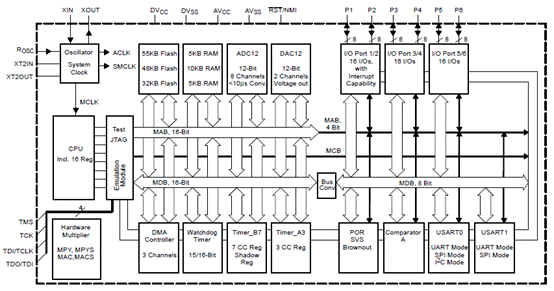
图1.MSP430F161x方框图
MSP-EXP430G2 低成本实验板
The MSP-EXP430G2 low-cost experimenter board called LaunchPad is a complete development solution for the Texas Instruments MSP430G2xx Value Line series. The integrated USB-based emulator offers all the hardware and software necessary to develop applications for all MSP430G2xx series devices. The LaunchPad has an integrated DIP target socket that supports up to 20 pins, allowing MSP430™ Value Line devices to be dropped into the LaunchPad board. It also offers an on-board flash emulation tool allowing direct interface to a PC for easy programming, debugging, and evaluation. The LaunchPad experimenter board is capable of programming the eZ430-RF2500T target boards, the eZ430-Chronos watch module or the eZ430-F2012T/F2013T target boards. The USB interface provides a 9600-Baud UART serial connection from the MSP430G2xx device to the host PC or a connected target board.
The MSP-EXP430G2 can be used with IAR Embedded Workbench™ Integrated Development Environment (IDE) or Code Composer Studio™ (CCS) IDE to write, download, and debug applications.
The debugger is unobtrusive, allowing the user to run an application at full speed with hardware breakpoints and single stepping available while consuming no extra hardware resources.
MSP-EXP430G2 LaunchPad主要特性:
• USB debugging and programming interface featuring a driverless installation and application UART serial communication with up to 9600 Baud
• Supports all MSP430G2xx and MSP430F20xx devices in PDIP14 or PDIP20 packages
• Two general-purpose digital I/O pins connected to green and red LEDs for visual feedback
• Two push button for user feedback and device reset
• Easily accessible device pins for debugging purposes or as socket for adding customized extension boards
• High-quality 20-pin DIP socket for an easy plug-in or removal of the target device
SLAU318B–
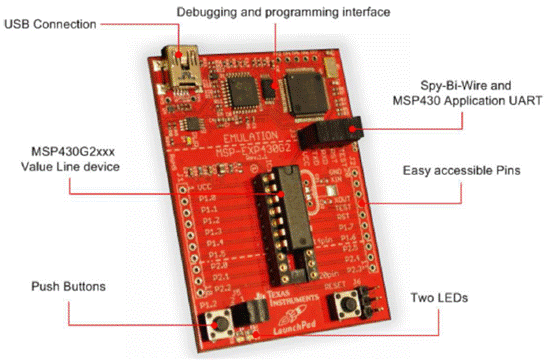
图2.MSP-EXP430G2 LaunchPad外形图
MSP-EXP430G2实验板包括:
The MSP-EXP430G2 experimenter kit includes the following hardware:
• LaunchPad emulator socket board (MSP-EXP430G2)
• Mini USB-B cable, 0.5 m
• Two MSP430 flash devices
– MSP430G2553: Low-power 16-bit MSP430 microcontroller with an 8-channel 10-bit ADC, on-chip comparator, touch-sense enabled I/Os, universal serial communication interface, 16kB flash memory, and 512 bytes of RAM (preloaded with a sample program)
– MSP430G2452: Low-power 16-bit MSP430 microcontroller with an 8-channel 10-bit ADC, on-chip comparator, touch-sense enabled I/Os, universal serial interface, 8kB flash memory, and 256 bytes of SRAM
• Two 10-pin PCB connectors female
• 32.768-kHz clock crystal from Micro Crystal (http://www.microcrystal.com)
• Quick start guide
• Two LaunchPad stickers
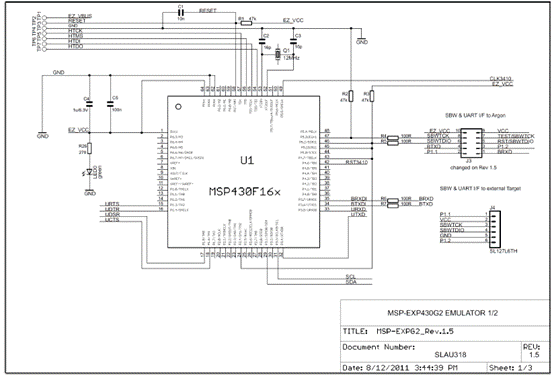
图3.MSP-EXP430G2 LaunchPad电路图(1)
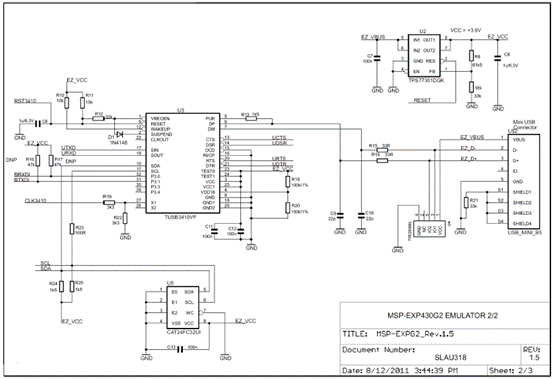
图4.MSP-EXP430G2 LaunchPad电路图(2)
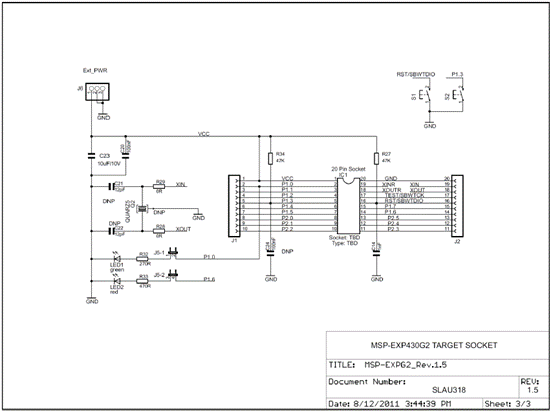
图5.MSP-EXP430G2 LaunchPad电路图(3)
MSP-EXP430G2 LaunchPad材料清单:
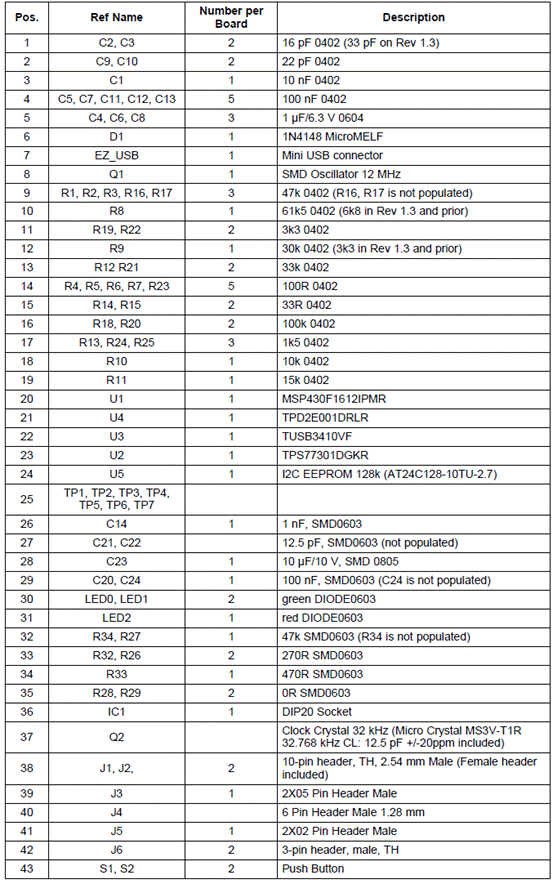
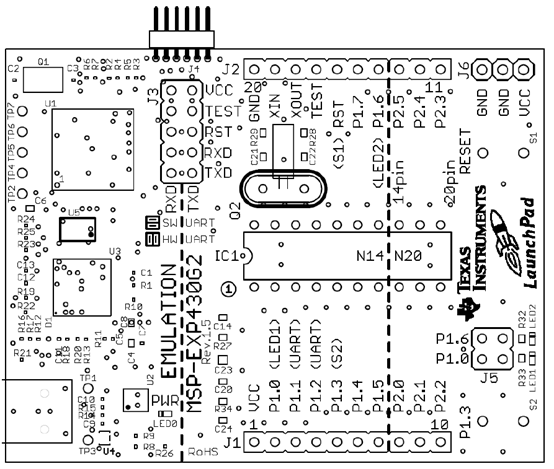
图6.MSP-EXP430G2 LaunchPad PCB元件布局图
详情请见:
 slas368g.pdf (1.47 MB, 下载次数: 3) 和 slas368g.pdf (1.47 MB, 下载次数: 3) 和
 slau318b.pdf (1.31 MB, 下载次数: 2) slau318b.pdf (1.31 MB, 下载次数: 2) |
|

